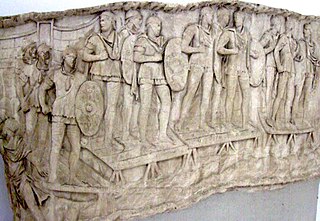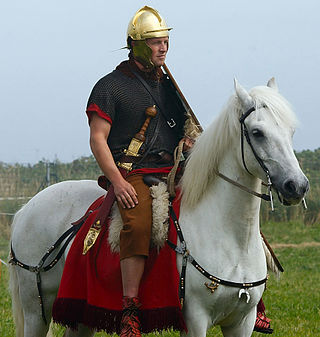 |
| Part of a series on the |
| Military of ancient Rome |
|---|
A decurion (Latin: decurio; pl.: decuriones) was a Roman cavalry officer in command of a squadron ( turma ) of cavalrymen in the Roman army.
 |
| Part of a series on the |
| Military of ancient Rome |
|---|
A decurion (Latin: decurio; pl.: decuriones) was a Roman cavalry officer in command of a squadron ( turma ) of cavalrymen in the Roman army.
During the Roman Republic a "Polybian" legion (c. 300–88 BC) of citizen-levies had a cavalry complement of 300 horse, divided into 10 turmae (squadrons) of 30 men each. Each turma was led by three decurions, who were elected by the squadron members themselves. Although decurio (lit. 'leader of ten men'), it does not appear that a turma was sub-divided into three troops of ten men each. Instead, one decurion would act as squadron commander and the other two as his deputies. [1]
In the Imperial Roman army of the Principate (30 BC – AD 284), a decurion also commanded a cavalry turma of c. 30 men, but now without colleagues. In common with all soldiers in the imperial army, decurions were long-service professionals, the majority volunteers.
A Roman imperial legion, which contained c. 5,600 men, contained a small cavalry arm of just 120 men (i.e., four turmae). Since the average number of legions deployed was c. 30, imperial legionary cavalry numbered only c. 3,600, out of a total of c. 80,000 cavalrymen deployed by the imperial army. There were thus c. 120 cavalry decurions in the legions at any given time.
The vast majority of the imperial cavalry was in the regiments of the auxilia , the non-citizen corps of the regular imperial army (whose recruits were mainly imperial subjects who did not hold Roman citizenship (known as peregrini ). An ala (lit. 'wing'), which was an elite all-cavalry regiment, contained 480 horse (16 turmae, thus 16 decurions). A double-strength ala (ala milliaria) contained 720 horse (24 turmae). c. 90alae were deployed in the time of emperor Hadrian (ruled 117–138). In addition, the auxiliary corps included a type of regiment known as a cohors equitata , an infantry unit with a cavalry complement of 120 horse (4 turmae; 8 in a double-strength unit). Around 180 such regiments existed under Hadrian. There were thus c. 2,500 decurions serving in the auxilia at any given time.
In the imperial period, decurions were no longer conscripted Romans, commoners who were often promoted from the ranks, but could also be members of native tribal aristocracies. (Roman knights at this stage only provided the overall commanders ( praefecti ) of the auxiliary regiments.) Thus, decurions in the imperial army were of far lower social status than their predecessors in the Republican cavalry. The latter were not only Roman citizens, but also aristocrats, whereas auxiliary decurions were mostly commoners and non-citizens (until AD 212, when all imperial subjects were granted citizenship). Even if they belonged to a native aristocracy, they ranked lower than a commoner Roman citizen in the status-conscious Roman empire.

The Roman legion, the largest military unit of the Roman army, comprised 4,200 infantry and 300 equites (cavalry) in the period of the Roman Republic and 5,600 infantry and 200 auxilia in the period of the Roman Empire.
The equites constituted the second of the property-based classes of ancient Rome, ranking below the senatorial class. A member of the equestrian order was known as an eques.

The Roman army was the armed forces deployed by the Romans throughout the duration of Ancient Rome, from the Roman Kingdom to the Roman Republic and the Roman Empire, and its medieval continuation, the Eastern Roman Empire. It is thus a term that may span approximately 2,205 years, during which the Roman armed forces underwent numerous permutations in size, composition, organisation, equipment and tactics, while conserving a core of lasting traditions.
An ala was the term used during the middle of the Roman Republic to denote a military formation composed of conscripts from the socii, Rome's Italian military allies. A normal consular army during the period consisted of two legions, composed of only Roman citizens, and two allied alae.

The auxilia were introduced as non-citizen troops attached to the citizen legions by Augustus after his reorganisation of the Imperial Roman army from 27 BC. By the 2nd century, the Auxilia contained the same number of infantry as the legions and, in addition, provided almost all of the Roman army's cavalry and more specialised troops. The auxilia thus represented three-fifths of Rome's regular land forces at that time. Like their legionary counterparts, auxiliary recruits were mostly volunteers, not conscripts.
The structural history of the Roman military concerns the major transformations in the organization and constitution of ancient Rome's armed forces, "the most effective and long-lived military institution known to history." At the highest level of structure, the forces were split into the Roman army and the Roman navy, although these two branches were less distinct than in many modern national defense forces. Within the top levels of both army and navy, structural changes occurred as a result of both positive military reform and organic structural evolution. These changes can be divided into four distinct phases.

In modern scholarship, the "late" period of the Roman army begins with the accession of the Emperor Diocletian in AD 284, and ends in 480 with the death of Julius Nepos, being roughly coterminous with the Dominate. During the period 395–476, the army of the Roman Empire's western half progressively disintegrated, while its counterpart in the East, known as the East Roman army remained largely intact in size and structure until the reign of Justinian I.

Tiberius Claudius Maximus was a cavalryman in the Imperial Roman army who served in the Roman legions and Auxilia under the emperors Domitian and Trajan in the period AD 85–117. He is noted for presenting Trajan with the head of Dacian king Decebalus, who had committed suicide after being surrounded by Roman cavalry at the end of Dacian Wars.
A turma, was a cavalry unit in the Roman army of the Republic and Empire. In the Byzantine Empire, it became applied to the larger, regiment-sized military-administrative divisions of a thema. The word is often translated as "squadron" but so is the term ala, a unit that was made up of several turmae.
Cohors secunda Gallorum veterana equitata was a mixed infantry and cavalry regiment of the Auxilia corps of the Imperial Roman army. It was stationed, in the 2nd and 3rd centuries, in a fort near Hadrian's Wall in Britain.
Cohors tertia Aquitanorum equitata civium Romanorum was a Roman auxiliary mixed infantry and cavalry regiment. It may have been originally raised in Gallia Aquitania in the reign of founder-emperor Augustus after the revolt of the Aquitani was suppressed in 26 BC. Alternatively, it may have been raised by emperor Claudius to replace regiments stationed in the newly annexed province of Britannia. Unlike most Gauls, the Aquitani were not Celtic-speaking but spoke Aquitanian, a now extinct non Indo-European language closely related to Basque.

The Alpine regiments of the Roman army were those auxiliary units of the army that were originally raised in the Alpine provinces of the Roman Empire: Tres Alpes, Raetia and Noricum. All these regions were inhabited by predominantly Rhaetian peoples and Celtic-speaking tribes. They were annexed, or at least occupied, by the emperor Augustus' forces during the period 25–14 BC. The term "Alpine" is used geographically in this context and does not necessarily imply that the regiments in question were specialised in mountain warfare. However, in the Julio-Claudian period, when the regiments were still largely composed of Alpine recruits, it is likely that they were especially adept at mountain operations.

This article concerns the Roman auxiliary regiments of the Principate period originally recruited in the western Alpine regions of the empire. The cohortes Alpinorum came from Tres Alpes, the three small Roman provinces of the western Alps, Alpes Maritimae, Alpes Cottiae and Alpes Graiae. The cohortes Ligurum were originally raised from the Ligures people of Alpes Maritimae and Liguria regio of NW Italia.

Roman cavalry refers to the horse-mounted forces of the Roman army throughout the regal, republican, and imperial eras.

The equites singulares Augusti were the cavalry arm of the Praetorian Guard during the Principate period of imperial Rome. Based in Rome, they escorted the Roman emperor whenever he left the city on a campaign or on tours of the provinces. The equites singulares Augusti were a highly trained unit dedicated to protecting the emperor. Men who served in the equites singulares Augusti held a Roman public status as equites.

The Roman army of the mid-Republic, also called the manipular Roman army or the Polybian army, refers to the armed forces deployed by the mid-Roman Republic, from the end of the Samnite Wars to the end of the Social War. The first phase of this army, in its manipular structure, is described in detail in the Histories of the ancient Greek historian Polybius, writing before 146 BC.

The Imperial Roman army was the military land force of the Roman Empire from 27 BC to 476 AD, and the final incarnation in the long history of the Roman army. This period is sometimes split into the Principate and the Dominate (284–476) periods.
Cohors PrimÆ Ælia Dacorvm was an infantry regiment of the Auxilia corps of the Imperial Roman army. It was first raised by the Roman emperor Hadrian in the Roman province of Dacia not later than AD 125 and its last surviving record dates c. 400. It was deployed, for virtually its entire history, in forts on Hadrian's Wall on the northern frontier of Britannia province.